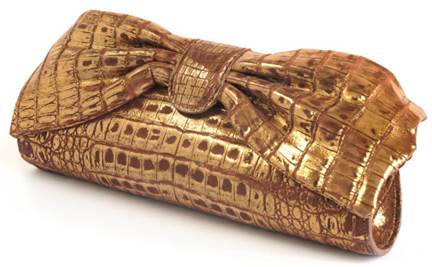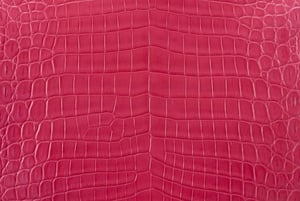
Crocodile skin is a luxurious, supple material that is very much in demand in the fashion industry. With high-fashion crocodile handbags selling for tens or even hundreds of thousands of dollars, getting the manufacture of your crocodile skin right is incredibly important for impressing ultra-wealthy clients.
When starting a crocodile handbag project, following a few simple tips can help you get the most out of your project.
Tip #1: Choosing Your Crocodilian Species
There are a few dozen different species of crocodiles in the world, a few of which are commonly used for leather. Two of the most popular are:
- The caiman crocodile.
- The Nile crocodile.
With handbags, you generally want to have a flexible material to use for the bag. The caiman crocodile has the boniest skin, rendering it less flexible and harder to work with. Nile crocodiles have some calcium deposits, but not nearly as much as caiman crocodiles do.
This boniness also affects how well each species of crocodile will take to being dyed, so keep that in mind as well. Bonier hides are tougher to dye evenly, while less bony hides are easier to dye.
Reasons to Work with Caiman Crocodile Skin
 With caiman skin being one of the more difficult of the most popular crocodilian hides to work with, why would you want to use it instead of Nile crocodile or American alligator skin for your handbag project? There are actually a few reasons for using caiman skin in your handbags over the other types of crocodilian species, such as:
With caiman skin being one of the more difficult of the most popular crocodilian hides to work with, why would you want to use it instead of Nile crocodile or American alligator skin for your handbag project? There are actually a few reasons for using caiman skin in your handbags over the other types of crocodilian species, such as:
- Cost. On average, for every Nile croc skin that you could afford for your leather project, you could buy three caiman skins for close to the same price.
- Rigidity. Often viewed as a negative quality, the rigidity of the caiman’s hide can actually be desirable for hard-case designs. The pronounced, calcium-rich scales in caiman skin are sturdy, making them ideal for a more rigid case design.
- Natural Scale Patterns. With caiman hides, the calcium deposits in the skin actively resist getting an even dye color. While this can make the skin more difficult to dye, it also helps to establish the final product as a genuine crocodile hide product. The lighter-colored portions of the hide represent a mark of the calcium in the hide. This adds authenticity to the final product and lets buyers know that they’re getting a genuine crocodile skin product, not a stamped imitation.
While generally regarded as being more difficult to work with than the other crocodilian hides, caiman skin is still a high-quality material for any high-fashion project. Using caiman skins to the greatest effect can separate the pros from the amateurs when it comes to fashion design.
Reasons to Work with Nile Crocodile Skin
 Nile crocodile skins are an ever-popular option for making exotic leather handbags. Some of the reasons Nile crocodile skin is virtually perfect for handbags include:
Nile crocodile skins are an ever-popular option for making exotic leather handbags. Some of the reasons Nile crocodile skin is virtually perfect for handbags include:
- Size. Most high-fashion handbag projects demand fairly large panels. Smaller leather hides, such as the caiman crocodile or the ring lizard cannot fill these panels with a single skin. This means having to stitch multiple hides together to fit a single panel, which can impact the appearance and integrity of the final product. Nile crocodile skins come in sizes of 13-15 ft. long and are up to 70 cm wide on average. This makes the Nile crocodile’s hide large enough to fit almost any handbag panel with a single skin.
- Appearance. The Nile crocodile offers a beautiful and distinctive aesthetic for fashion designers, one that is instantly distinguishable from common cowhide. Nile crocodiles have some of the largest belly scales of any crocodilian species. There are 14-16 large square-shaped scales per row on a Nile crocodile’s belly and 24-26 rows of scales in total. The minimal level of calcium content in these scales makes them relatively easy to dye. This makes getting consistent colors easier than it would be with a bonier hide, such as caiman crocodile hide. Hides from Nile crocodiles have weak to medium surface pitting, helping create a distinctive appearance without being excessively pitted.
- Flexibility. While Nile crocodiles have some bone content in their hides, it’s less than a tenth of what you’d find in a caiman crocodile hide. This makes the skin of a Nile crocodile much more flexible than caiman skin. This is great for handbags, which may be subjected to repeated flexing as they’re handled. The added flexibility helps to prevent crease marks from forming, preserving the pristine appearance of the handbag for longer. Additionally, the flexibility of the hide makes it easier to work with than bony hides, but some extra prep work with a Dremel to thin the hide before sewing it is still recommended.
Nile crocodile skins are ideal for making handbags, which might explain why they’re in such high demand. Don’t miss out on an opportunity to work with this top-shelf exotic material for your own high-fashion project!
Tip #2: Choosing the Size and Grade of Hides
With handbags, you’ll need to use very large, clean panels of skin for each bag. High-fashion handbag customers want only top-quality workmanship and materials, so top-grade skins will be the most desirable. In most cases, you will need nearly flawless, grade I skin to get the best results.
For small handbags, the crocodile hide should be at least 30 to 34cm wide. Medium-sized handbags generally need 35 to 39cm-wide skins, and large handbags take 40 to 50cm-wide grade I skins. If flaws in the skin are kept to the extreme edges of the hide, you might be able to use a grade II skin that is oversized.
Tip #3: Using Scraps for Straps
If the layout of your panels leaves you with excess hide, use that extra skin to make the carry strap, gussets, interior details, and other odd parts. This can save you a large amount of money on buying extra skins and gives you accents that will perfectly match the handbag they are attached to.
If you don’t have enough excess material to do this, consider buying smaller, grade II or III skins to make into carry straps. With these straps, it’s easier to work around flaws in the hide, as long as they aren’t extra-wide. When buying hides specifically for straps, make sure that they’re the same type of cut (belly or hornback, for example) and come from the same dye lot as the ones being used for the bags themselves.
Tip #4: Preparing Sewing Lines
When working with bonier hides such as caiman or Nile crocodile skins, be sure to prepare sewing lines with a dremel or other tool to thin the hide and prevent calcium deposits from bending or breaking your needles. In the long run, taking a few minutes to prepare sewing lines will actually save you time and frustration on fixing up your sewing machines and replacing needles every other motion.
To get more tips about working with caiman hides for handbags and other popular accessories, contact Pan American Leathers. Or, you can get a free project consultation today using the link below.



